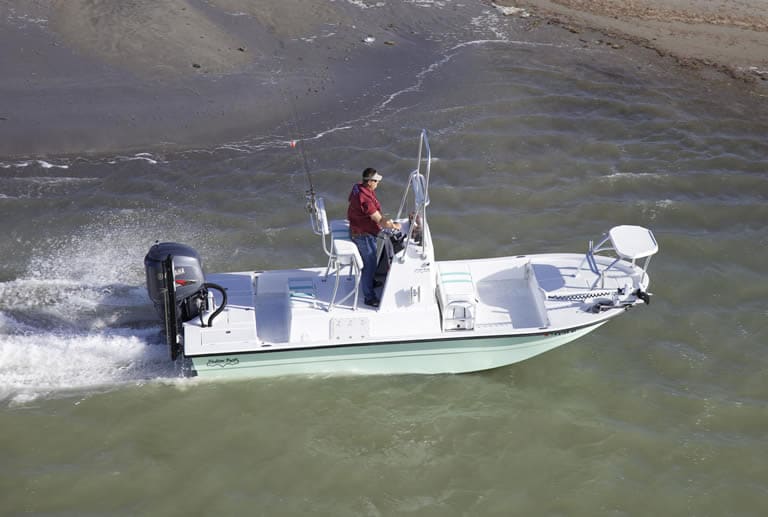When it comes to boating, different types of boats with different hull designs perform better in different types of environments. For example a deep v-hull boat is perfect for ocean waters while such a boat is unsuitable for shallow waters. However, not all shallow water boats are ideal for every shallow water activity.
Contents
- 9 Top Flat Bottom Boats For Specific Uses
- The Best Flat Bottom Boats For 9 Water-Based Activities
- Best boat for solo shallow water boating
- Best boat for shallow water angling
- Best shallow water boat for hunting
- Best shallow boat for shoreline/ocean use
- Best shallow water boat for lakes
- Best shallow water boat for wetlands
- Best shallow water boat for camping
- Best shallow water boat for recreational use
- Best all-round shallow water boat
- Some last minute tips for navigating shallow waters safely
9 Top Flat Bottom Boats For Specific Uses
In this article you will learn the difference between the types of shallow water boat available so you can tell which one is the best choice for you?
Flat bottom boats are best for navigating shallow waterways such as rivers, creeks, lakes or shorelines.
There are various flat bottom boat designs available and each boat type has characteristics suited to specific shallow water environments and specific activities.
The best flat bottom boat for you will depend on several different considerations.
Why a flat bottom hull works so well in shallow water
The flat bottom hull design of shallow water boats makes these nimble watercraft less likely to ground in shallow waters than classic v-hulled boats.
They are also extremely stable on calm shallow waters making them an ideal choice for recreational use and a great pick for hunting and angling on inland waterways.
Navigating shallow water can be challenging when boating in a v-hull, or even semi-v hull boat.
It is easy to accidentally ground a boat or just get it stuck in shallows, and if you hit debris like rocks it is all too easy to damage your boat hull and its propeller.
If the prop goes, your boat is dead in the water and you will likely have an expensive repair or replacement to deal with.
If the bottom of your boat hits rocks the damage can be extreme and you may even sink.
Likewise, if you overdrive a non-flat-bottomed vessel in shallow waters, and you or your passengers can be thrown off.
The beauty of a shallow draft
Non flat-bottomed boats run the very high risk of taking a significant battering in waters with shallow areas.
Your boat’s draft will be a key determinant of what you will be able to get away with (see shallow draft vs deep draft).
The tricky thing is that shallow water is not always easy to detect until you’re right on top if it.
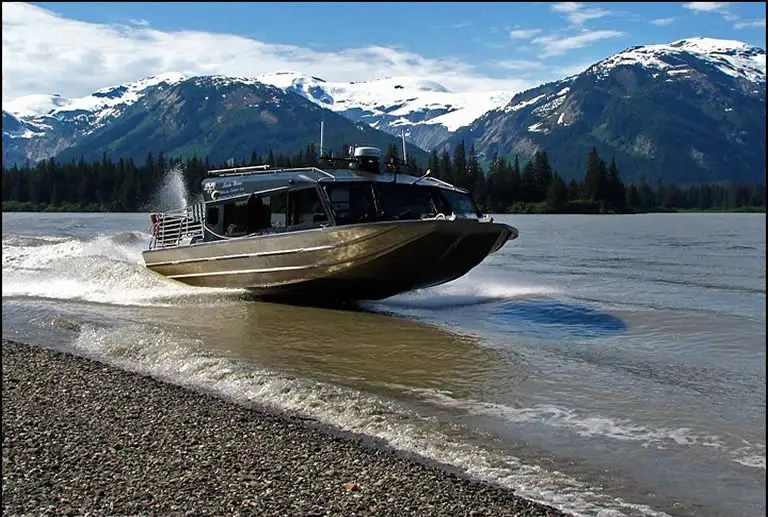
So safe inland waterway boating requires vigilance for shallow areas that may not be obvious if you choose to boat in anything but a flat-bottomed vessel.
A flat bottom boat however offers both stability and a greatly decreased risk of grounding and/or damaging the bottom of the boat on debris. This is due to its very shallow draft (its bottom does not sit very far down into the water).
Flat bottom boats are the only type of boats you should be using in shallow waters.
We outlined the advantages and disadvantages of using a flat bottom boat in this article.
Stability without compare
The vast majority of shallow waters are found in inland bodies of water whether they be lakes, creeks, rivers or canals.
As most inland waters are more protected from winds they tend to be calmer than large open areas of water such as the ocean.
This means shallow inland waters tend to be very calm.
Even in medium winds very shallow areas of water will still remain fairly calm.
The flat bottom design of a shallow water boat means its bottom is fairly close to the surface of the water unlike boats designed to navigate deeper waters.
Think in terms of a flat bottom boat as sitting on the surface of the water rather than sitting deep in the water like a v-hull boat.
This means a flat bottom boat has great stability on calm water because there is very little “rocking” going on. As it sits more on the water than in it a flat bottom boat almost glides over the water.
This makes the boating experience not only stable but very comfortable even at speed.
When should you always use a shallow water boat?
Shallow water is defined by having a depth which is equal to or less than half of the wavelength.
At this depth, the physical characteristics of the bottom affect surface waves.
Shallow water may be found in any body of water or waterway but are especially evident in inland waters or shorelines.
You can expect to encounter shallow water areas in muddy estuaries, rivers, creeks, coastal reefs, or shallow lakes.
With a flat-bottomed boat you will be significantly advantaged in these environments.
But not all flat bottom boats are a great fit for all shallow waters or shallow water pursuits!
Choosing the best shallow water boat for a specific marine environment and a specified purpose will keep you and your boat safe.
But, it will also make your boating experience easier and much more pleasurable.
Below we outline the best shallow water boat type based on the activity it will be used for and the marine environment it will be used in.
The Best Flat Bottom Boats For 9 Water-Based Activities
Not all flat bottom boats are the same.
Below I have included the best types of flat bottom boat based on specific marine activities.
Best boat for solo shallow water boating
A flat-bottomed kayak is an ideal and versatile choice of flat-bottom boat for solo exploration in calm, shallow waters.
The flat hull offers great stability and a shallow draft for easy navigation in shallow waters.
This lightweight watercraft is also compact and easy to maneuver, meaning you can get into nooks that larger vessels cannot.
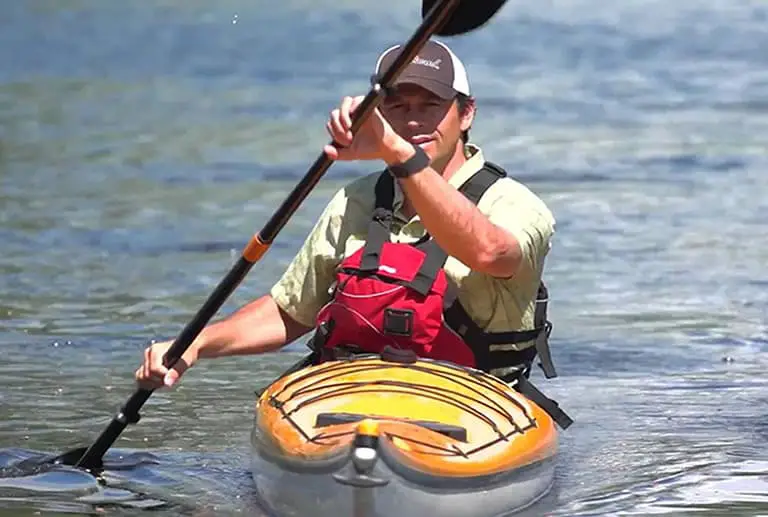
Kayaks also make great fishing vessels on both inland waters and on open water though you will need a different type of kayak for each (as we covered here).
It is important to note that a flat-bottomed kayak will struggle in rough and choppy waters, where a V-hull is better for cutting through waves.
A flat bottom kayak is the ideal choice of kayak for shallow waters as it offers great stability and easy access to extremely shallow areas.
To see a host of other reasons for choosing a flat bottom kayak read this article.
A small Jon boat is also ideal for using alone in shallow waters.
Best boat for shallow water angling
Skiffs can be small or fairly large, but are always lightweight flat-bottomed vessels with a shallow draft. Modern skiffs are usually powered by an outboard motor.
Although skiffs come in all sizes the larger vessels offer the same type of comfortable seating you would expect from a power boat but have ample storage for a small crew and gear.
Most skiffs are kitted out for fishing and, like a Jon boat (which is also a good choice for anglers), can be deliberately beached for fishing in shallow shoreline areas.
They offer a stable level surface that can accommodate one or two people standing up and casting off comfortably.
Unlike a Jon boat many skiffs will have an elevated sitting position for the driver.
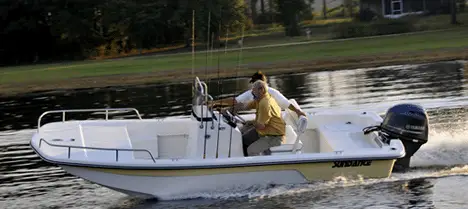
This diverse class of flat-bottomed vessel is great for recreation and exploration.
Skiffs are not only great for fishing in inland waters but work great for use close to an ocean shoreline.
The featured image at the top of this page shows a typical skiff.
Kayaks, canoes and Jon boats are also excellent choices for fishing in shallow waters.
Like a kayak you will need a specific design of canoe for the job which you can read about here.
Best shallow water boat for hunting
A Jon boat is a good all-rounder and lends itself to providing the steady, stable deck you will need for a successful hunting expedition.
This includes bow hunting (though you may want a modified boat with a modified shooting platform).
These versatile shallow water craft are easily customized for a range of activities and can be easily camouflaged for hunting.
A Jon boat can accommodate crew and gear while still remaining lightweight and incredibly easy to handle.
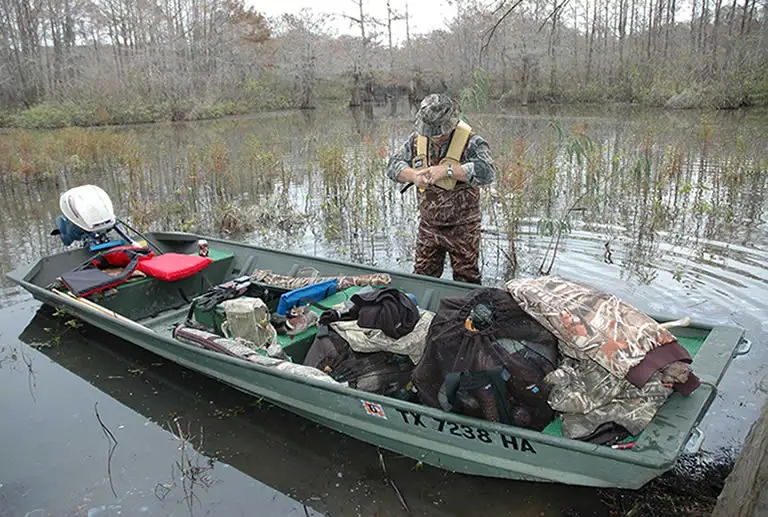
You may be surprised at just how much weight a Jon boat can hold.
A Jon boat with a modest trolling motor will provide quiet and controlled propulsion and with the addition of a paddle or pole gives the hunter the advantage of stealth when approaching prey.
As a trolling motor is equipped to lift the propeller out of the water, and with the aid of some form of manual propulsion such as a paddle or pole, a Jon boat also allows for easy access to waters that are only a few inches deep.
This allows hunters to get close to banks for more accurate shooting.
Without doubt the only boat you will ever need for hunting is a Jon boat.
To learn more about Jon boats and there many other uses read this article.
Best shallow boat for shoreline/ocean use
Dorys are small, flat bottomed shallow draft boats which are specifically designed for shoreline angling.
They are often fitted with small sails or oars.
Known around the world as a traditional fishing vessel, Dorys have a simple design.
They are flat-bottomed and surprisingly versatile, being readily paired with the outboard motor of your choice if rowing or sailing is not your thing.
Dorys share some similarities with Jon boats but come in a variety of designs.
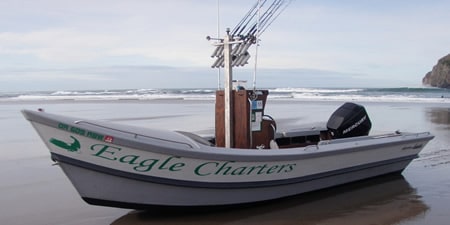
All dorys have a shallow draft and flat bottom for navigating shorelines, estuaries or shallow bays.
Kayaks and skiffs are also an excellent choice for shoreline use.
If you plan to use a kayak then you will need a sea or touring kayak which is designed for use in turbulent sea waters.
They offer excellent enclosed storage for camping equipment and supplies and long haul journeys. Unfortunately this storage is only accessible when your boat is out of the water.
For shoreline angling an ocean fishing kayak is a very popular choice.
Best shallow water boat for lakes
If you have a favorite lake or chain of lakes any aluminum flat-bottom boat with an outboard motor and/or oars is the best bet for being able to traverse what would have been no-go areas.
Shallow lakes are beautiful but have all sorts of hazards like logs, rocks weeds and extremely shallow areas.
Alternating between oars and a trimmable outboard, should allow you the ability to get across shallow bodies of water easily and safely.
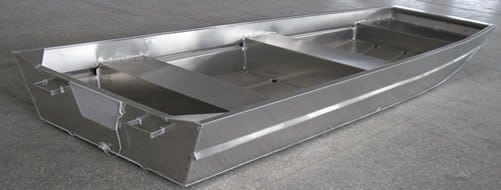
If rowing is not for you, a jet motor does the hard work of propulsion without the risk of propeller damage.
Be aware though that jet motors tend to suck up debris from the water’s bottom debris when in shallow areas which can lead to problems.
Best shallow water boat for wetlands
The iconic airboat is synonymous with navigating the open expanse of wetlands, deftly and at high speed.
Given the inherent risks of mud, weeds and mangrove tree roots, this lightweight flat bottomed vessel removes the problem of submerged operating parts.
It does this by having an aircraft propeller up top at the stern and no parts below the hull.
The flat bottom design design of an airboat twinned with its above-water propulsion method means this type of is capable of moving over shallow water of just a few inches deep.
It also means an airboat can also reach speeds of up to 40 mph.
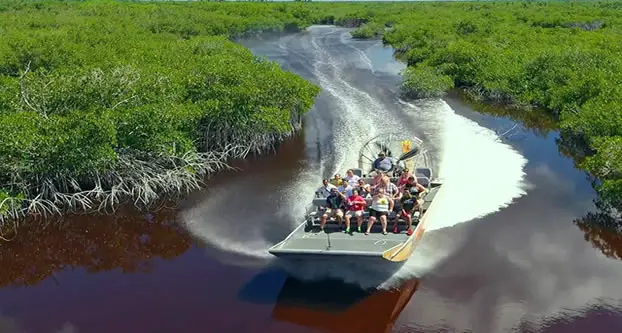
The flat bottom design means an airboat can easily avoid the type of obstructions beneath the waterline found in marshland and swamps.
Although not as popular or versatile as airboats for marshland and wetland environments, flat bottom skiffs and Jon boats are an adequate alternative.
Airboats are also popular for shallow river and creek use though not as popular as Jon boats.
Best shallow water boat for camping
The most popular shallow water boats for camping are kayaks. Ocean and touring kayaks are ideal for long haul journeys or just a weekend away.
However, they are usually solo craft or kitted out to carry 2 people maximum.
For family camping outings a Jon boat or flat bottom canoe are excellent choices.
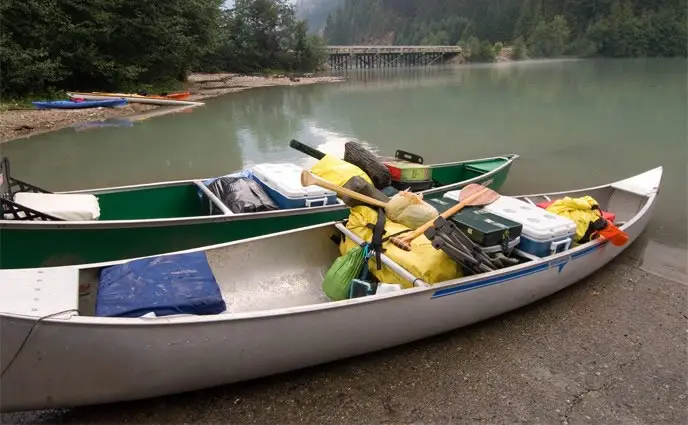
Both vessels can navigate shallow water easily, be manually propelled or fitted with an outboard motor and both have ample storage space.
You can read our guide to boat camping here if you want more detailed information about this popular boating activity.
Best shallow water boat for recreational use
Any of the above mentioned shallow water boats are ideal for recreational use. However, if you want to do it in style consider a canoe.
Whichever boat you choose just be sure that it is cable of navigating the waterways in which you intend to use it.
For example, a large skiff may not be the best choice for narrow rivers with water areas that are only a few inches deep.
A Jon boat with trolling motor and paddle, or a canoe or kayak would be a much better choice.
For us, the best option is a kayak – especially if you want to include the whole family.
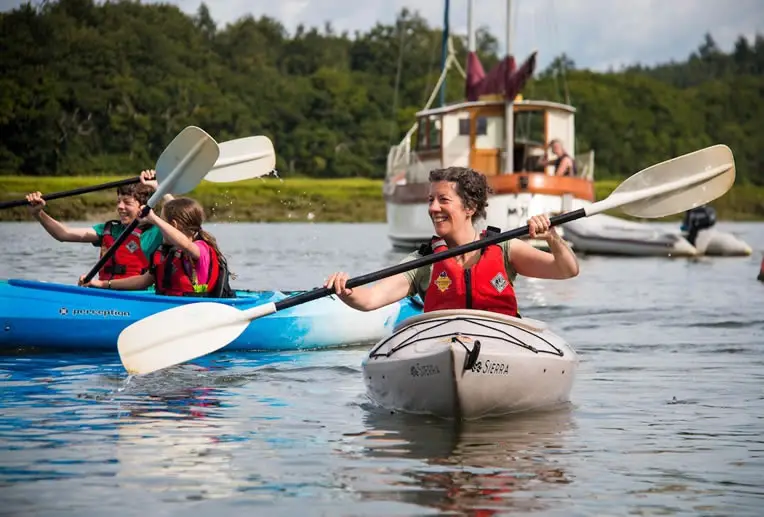
If you plan to navigate rivers and creeks then read this article to find the best shallow water river boat for your specific needs.
Also be sure to check out the rest of this website for a better understanding of each of the boat types mentioned in this article.
Best all-round shallow water boat
By far the best, and most popular, shallow water boat is a Jon boat.
If we had to pick an outright winner for best shallow water boat it would have to be the Jon boat!
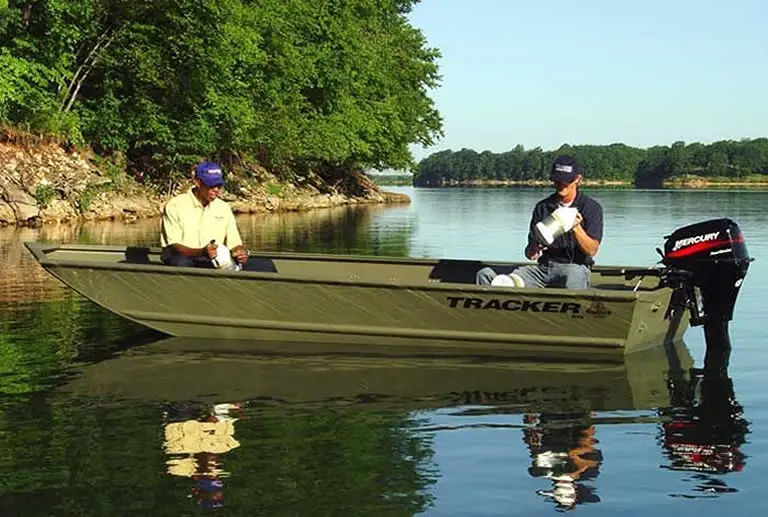
A Jon boat is such a versatile vessel that it can be used in just about every shallow water environment and under the right conditions can also be used in the ocean.
If you know you will be in shallow water it is best to be prepared and vigilant while out on the water.
For smaller lightweight craft, a paddle or pole is are well worth having on board, in the event of an outboard propeller becoming damaged, or when you need to trim the motor.
Oars can also be used if your boat has oarlocks attached. If it doesn’t have fittings for oars then attaching them yourself is an easy enough job even on a Jon boat.
However, rowing a boat through shallows can also be problematic if the water is extremely shallow. In such conditions a paddle would be a better choice.
In the event of becoming stuck, or grounded, poles are by far the best bet to help gently pry you out.
If you intend to regularly use an outboard motor in shallow waters then a cheap but good quality depth sonar, or a more expensive fish finder
(which we demonstrated is easy to install), is a worthwhile piece of kit.
Such a device can be used to quickly and easily monitor depth, especially in water you have not navigated before.
As a rule-of-thumb, when moving through unfamiliar shallow water via outboard propulsion, slow down and be ready to trim up quickly when needed.
If you are concerned about possible damage to your outboard an aluminum propeller may be a hardier choice for you.
If you do plan to risk your propeller in unknown shallow waters it may be a good idea to carry a spare in your vehicle just in case.
Also, if you do hit something remember to check the bottom of your boat and your outboard motor on your return so you can repair any damage promptly and avoid the damage getting any worse.

